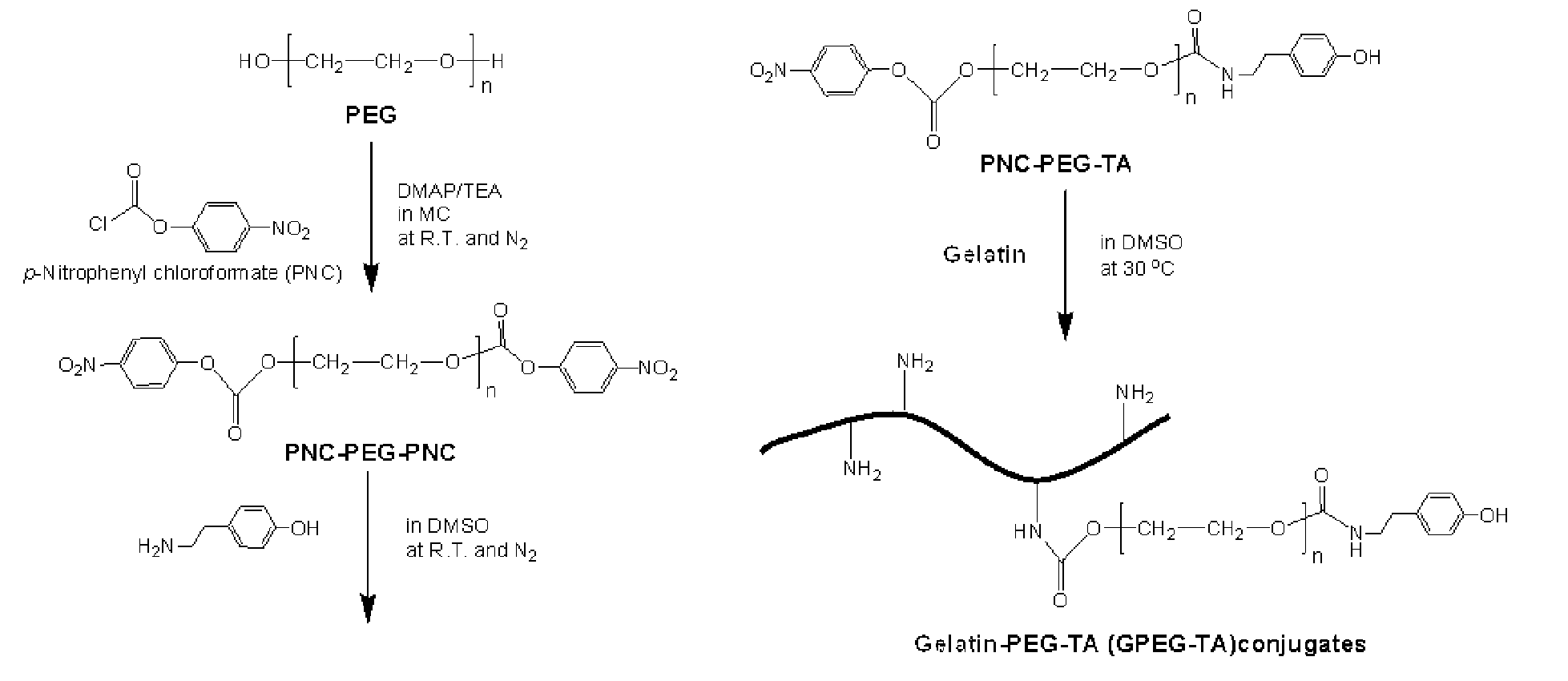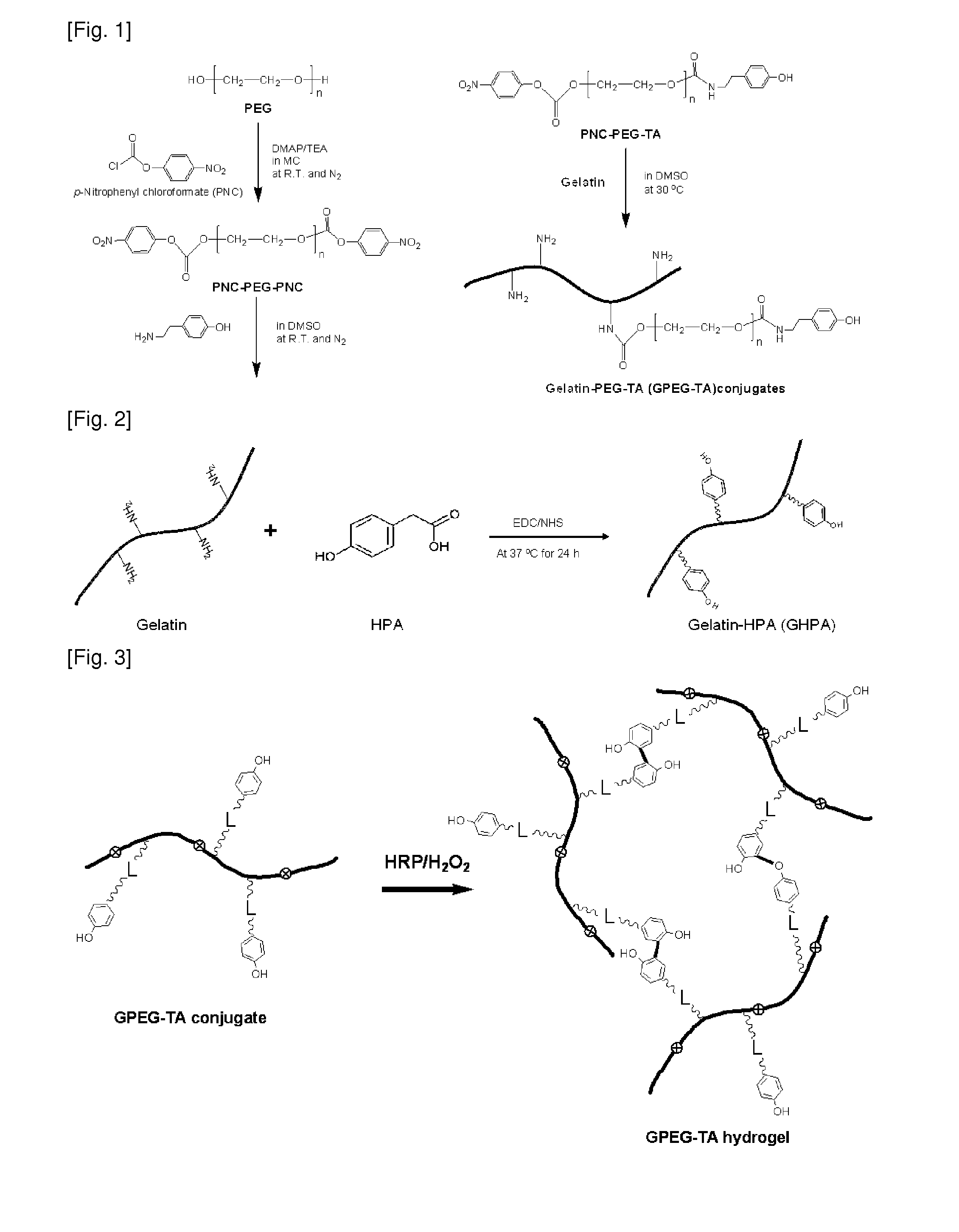In situ forming hydrogel and biomedical use thereof
a technology of hydrogel and hydrogel, which is applied in the direction of depsipeptides, peptide/protein ingredients, macromolecule non-active ingredients, etc., can solve the problems of in-situ formation hydrogel, low mechanical strength and stability, and long preparation period, so as to improve the solubility of the polymer backbone, improve the solubility, and improve the mechanical strength.
- Summary
- Abstract
- Description
- Claims
- Application Information
AI Technical Summary
Benefits of technology
Problems solved by technology
Method used
Image
Examples
preparation example 1
Synthesis of Gelatin-PEG-Tyramine (GPEG-TA)
[0075]FIG. 1 is a reaction scheme for the synthesis of a GPEG-TA copolymer.
1. Synthesis of Poly(Ethyleneglycol)-(P-Nitrophenyl Chloroformate) (PEG-NPCF)
[0076]A solution of 10 g (2.9 mmol) of PEG in 100 mL of methylene chloride (MC) was mixed sequentially with a solution of 0.779 g (6.38 mmol) of DMAP and 0.645 g (6.38 mmol) of TEA in 10 mL of MC and a solution of 1.286 g (6.38 mmol) of NPCF in 50 mL of MC. The molar ratio of PEG:DMAP:TEA:NPCF was 1:2.2:2.2:2.2. The reaction was performed at 30° C. for 24 hrs in a nitrogen atmosphere.
[0077]After completion of the reaction, a filter was used to filter the reaction mixture and remove unreacted reagents and the reaction mixture was then concentrated using a rotary evaporator. The concentrate was dropwise added to 1600 mL of chilled ether to form precipitates which were then obtained by filtration. The filtrate thus obtained was allowed to stand for 24 hrs in a vacuum oven to remove the remainin...
preparation example 2
Synthesis of Gelatin-Hydroxyphenylacetic Acid (GHPA)
[0080]FIG. 2 is a reaction scheme showing the synthesis of GHPA.
[0081]10 Grams of gelatin was dissolved in 200 mL of 0.1 M 2-(N-morpholino)ethanesulfonic acid (MES) to prepare solution A. Separately, 0.609 g of (4 mmol) of 4-hydroxyphenylacetic acid (HPA) was dissolved in 50 mL of 0.1 M MES to furnish solution B. 0.92 Grams (4.8 mmol) of 1-ethyl-3-(3-dimethylaminopropyl)-carbodiimide (EDC) and 0.276 g (2.4 mmol) of N-hydroxysuccinimide (NHS) were each dissolved in 5 mL of 0.1 M MES.
[0082]The EDC solution and the NHS solution were sequentially at intervals of 15 min to the solution B. 15 Min after addition of the NHS solution, the solution B activated with EDC / NHS was mixed with the solution A. The reaction was performed at 40° C. for 24 hrs.
[0083]After completion of the reaction, the reaction mixture was filtered through a syringe filter (450 nm). Then, the filtrate was subjected to membrane dialysis against distilled water (cutoff...
example 1
Preparation of GPEG-TA Hydrogel Using Enzymatic Reaction
[0084]A solution of GPEG-TA in HRP (solution A) was mixed with a solution of GPEG-TA in H2O2 (solution B) to prepare a hydrogel. The polymer solutions were controlled to have a final concentration of from 1 to 20 wt % and were applied in various forms using a dual syringe kit or a spray kit or by Teflon molding.
[0085]GHPA and CHPA, GPEG-TA, or CPEG-TA was dissolved in H2O2 (solution B) and mixed with a solution of Tet-TA / DA in HRP (solution A) to prepare a hydrogel.
[0086]GHPA hydrogel could have been prepared in the same manner. However, it was possible to control the final concentration of GHPA to range only between 5 and 10 wt %. At a concentration of 10 wt %, it was practically difficult to deal with the polymer solutions due to high viscosity. In contrast, GPEG-TA, a polymer with PEG introduced thereinto, was highly soluble in water and thus the polymer solutions were comparably easy to manage thanks to the low viscosity th...
PUM
| Property | Measurement | Unit |
|---|---|---|
| Fraction | aaaaa | aaaaa |
| Fraction | aaaaa | aaaaa |
| Fraction | aaaaa | aaaaa |
Abstract
Description
Claims
Application Information
 Login to View More
Login to View More - R&D
- Intellectual Property
- Life Sciences
- Materials
- Tech Scout
- Unparalleled Data Quality
- Higher Quality Content
- 60% Fewer Hallucinations
Browse by: Latest US Patents, China's latest patents, Technical Efficacy Thesaurus, Application Domain, Technology Topic, Popular Technical Reports.
© 2025 PatSnap. All rights reserved.Legal|Privacy policy|Modern Slavery Act Transparency Statement|Sitemap|About US| Contact US: help@patsnap.com



